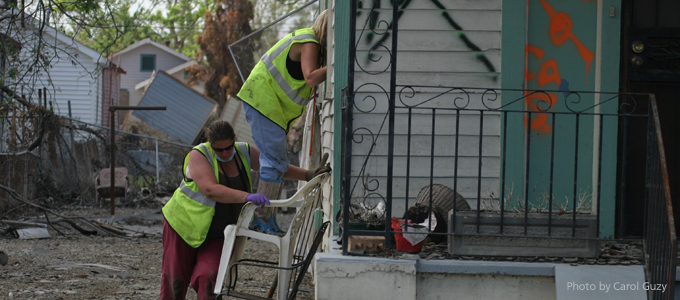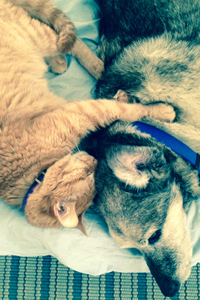August 23, 2015
Hurricane Katrina
RESCUE

The rescue efforts after Hurricane Katrina – for both humans and animals – were astounding, and extended weeks after the flooding receded.
Paula Kislak, DVM, President of the HSVMA Board of Directors, helped with animal rescue and recovery efforts during the period September 24 - October 10, 2005. At the time, Dr. Kislak was employed practicing small animal medicine, however she was not paid for her time in the Gulf Coast region. She, alongside her colleague and friend, Dr. Madeline (Madi) Graham, worked as rescuers. Both veterinarians did most of their rescue and recovery work, “cajoling and trapping loose animals,” in St. Bernard Parish, in the Lower Ninth Ward of Louisiana. Together they averaged more than a dozen animal rescues a day. Dr. Kislak is now involved in non-profit animal protection and advocacy work.
What follows are excerpts from a personal diary written by Denny Green, Dr. Graham’s husband, as the narratives were recounted to him during their nightly phone conversations.
Day 12
Madi keeps saying, there are too many dogs that are not barking. And, cats don't bark.
Day 13
It was the next dog that was the big punch of the day. They found this one by following up on a spray-painted sign by the Army on the outside of a building that said "one canine, 9/16." Today was 9/25. They went up to the third story. The exterior door had been smashed open by the military. There was a large piece of plywood hanging by one nail in front of the apartment. It was kind of propped open. They thought the dog had gotten out and was gone. They didn't hear any dog sounds. Didn't see any poop, pee or footprints. They gave the place a cursory look. Madi passed the kitchen, noticed the floor was white. When she passed it again something caught her eye. A white dog was lying on the white floor, chained to the stove. It was breathing, but not moving. It was covered in its own wet feces. They were shocked. Paula took the emaciated creature in her arms and Madi cut the chain. They ran outside and rinsed it. It was a female pit bull. She took a couple of laps of water and a little food. They tried to stand her up after a while. She stayed up a second or two, then fell over like a board. They ended up going outside of New Orleans and found a vet clinic that had just closed. They got a vet tech to let them in and the vet who was still there helped them put in an IV catheter. They bathed her. She rode on Madi's lap as they took her to the Winn-Dixie shelter in New Orleans, all kinds of sweet things being cooed into her ear. It was too late in the day to get her to the Gonzalez shelter. Gonzalez did have vets—but only until 8 p.m. The Pasado shelter was another hour and 45 minutes out of the way. The vet tech at Winn-Dixie was overworked. She was offended when Madi and Paula turned down the rate of flow of the IV fluids. You can kill a starving animal if you run the fluids too fast. They left her there hoping they'd made the right choice of shelters. They thought slow feeding and hydrating and the dog ought to be able to make it. They named her Venus after the bright evening star in the sky...
The next day firefighter rescuers who had Madi and Paula's cell phone numbers found a dog. Madi and Paula were two blocks away and had to use the rabies pole on what Madi called a really hostile and aggressive Rottweiler. Then they were off looking for more. The second dog was also mean. They had to use the rabies pole again. This one was hiding under a house and wouldn't come out. They put an opened can of dog food out at the edge of the house and hung the open noose of the rabies pole between the dog and the can. He made a move for the food and they snagged him. The dog had a buddy who lay dead in the front yard. Madi said it looked semi-mummified…
I asked Madi if they were seeing many dead animals. We've seen a lot of dead animals, she said. They saw a dog impaled on a fence. While searching a house, Paula came upon two dead dogs. One was in a crate, one had been loose in the house. They lay side by side, separated by the thin plastic wall of the crate.
Day 14
 Katrina-rescue, Floyd now lives happily with Dr. Kislak, where he has established his feline dominance over his canine housemates. Dr. Paula KislakToday they saw one that took them aback. While looking around a house they turned a corner where they found a big black dog hanging out of a window, long dead. He had tried to escape the house by squeezing through the space between a window air conditioner and the window jamb. He had gotten most of the way out, but his hips hadn't gotten through. He was hanging by his hips, his eyes bulging and his tongue a mile long. It was haunting. So many reminders, finding them alive, finding them dead. The urgency is real. They keep moving, wanting and hoping to make the difference...
Two patrolling U.S. Marshals approached them to say they saw a little orange kitten down the street. They caught him. He seemed to be alone. He was very thin, about four months old. They were surprised he was surviving with packs of hungry dogs loose and prowling for three weeks now. They went around the corner to set out food and water for the strays when they saw another little orange kitten. He was very spooked and ran away. They left him food and water. Then another appeared. Madi grabbed him. He scratched her, but didn't bite. Then an orange tom cat walked up meowing and they picked him up too. They thought he was the dad. They took them all to the Winn-Dixie operation but as they were leaving they saw him panting. Not surprising since it was 90 degrees at 10 p.m. and 90% humidity. Paula went back to the registration desk and tore up his card and took him with them. They left him at a vet clinic outside of the town for 10 days where he was neutered, tested (heartworm-positive) and vaccinated and 10 years later he is living with Paula in Santa Barbara where he rules over a household of greyhound and mutts (she named him "Floyd" after a family that gave her a place to stay in Louisiana)...
Day 15
They saw "CANINE" written by firefighters on the next door they bashed in. The place was clean, no poops, no dog prints. She called "Puppy, puppy!" No response. She said, we constantly have to decide when to continue looking, when to move on. Time is precious, and we don't want to waste it. But, she's found when "CANINE" is on the building, it has been very accurate, failing them only once. So, she moved deeper into the house. She saw fresh poop. Didn't see or hear anything else. She went into the rearmost room. She heard a little shuffle. Then she saw it. A skinny brindle-colored dog with its head stuck in a plastic mayonnaise jar. The jar was filthy. Madi caught her up. She tried to pull the jar off. It wouldn't come off. She got nervous. It seemed on pretty tight. She pulled again, this time the dog seemed to understand and pulled back. The dog wagged its tail. But the jar wouldn't budge. She scooped her up and ran outside. Fumbling and panicking, she used wire cutters, and cut the jar, worried she might cut her ear in the process. She slid the jar off, and the dog was all over her, licking her face, tail wagging, and wouldn’t get off her lap. She inhaled the food and water they gave her. She was sweet as sweet could be, Madi said. Madi named her "Jughead." How long had the jar been stuck? No idea. Imagine the heat and humidity in these closed-up houses, and add to that a jar over your head!
|